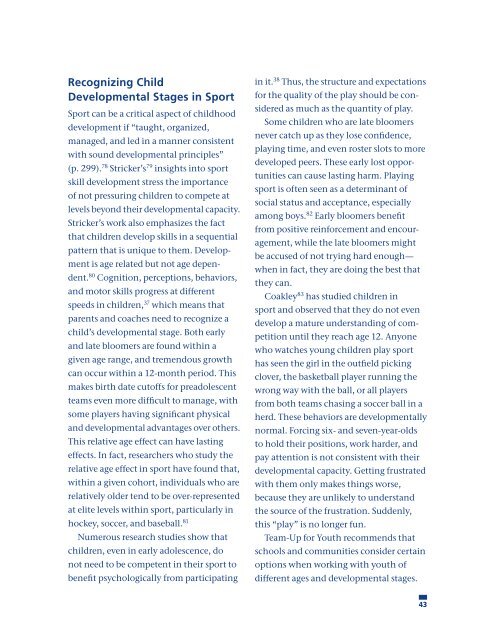True-Sport-Report
You also want an ePaper? Increase the reach of your titles
YUMPU automatically turns print PDFs into web optimized ePapers that Google loves.
Recognizing Child<br />
Developmental Stages in <strong>Sport</strong><br />
<strong>Sport</strong> can be a critical aspect of childhood<br />
development if “taught, organized,<br />
managed, and led in a manner consistent<br />
with sound developmental principles”<br />
(p. 299). 78 Stricker’s 79 insights into sport<br />
skill development stress the importance<br />
of not pressuring children to compete at<br />
levels beyond their developmental capacity.<br />
Stricker’s work also emphasizes the fact<br />
that children develop skills in a sequential<br />
pattern that is unique to them. Development<br />
is age related but not age dependent.<br />
80 Cognition, perceptions, behaviors,<br />
and motor skills progress at different<br />
speeds in children, 37 which means that<br />
parents and coaches need to recognize a<br />
child’s developmental stage. Both early<br />
and late bloomers are found within a<br />
given age range, and tremendous growth<br />
can occur within a 12-month period. This<br />
makes birth date cutoffs for preadolescent<br />
teams even more difficult to manage, with<br />
some players having significant physical<br />
and developmental advantages over others.<br />
This relative age effect can have lasting<br />
effects. In fact, researchers who study the<br />
relative age effect in sport have found that,<br />
within a given cohort, individuals who are<br />
relatively older tend to be over-represented<br />
at elite levels within sport, particularly in<br />
hockey, soccer, and baseball. 81<br />
Numerous research studies show that<br />
children, even in early adolescence, do<br />
not need to be competent in their sport to<br />
benefit psychologically from participating<br />
in it. 38 Thus, the structure and expectations<br />
for the quality of the play should be considered<br />
as much as the quantity of play.<br />
Some children who are late bloomers<br />
never catch up as they lose confidence,<br />
playing time, and even roster slots to more<br />
developed peers. These early lost opportunities<br />
can cause lasting harm. Playing<br />
sport is often seen as a determinant of<br />
social status and acceptance, especially<br />
among boys. 82 Early bloomers benefit<br />
from positive reinforcement and encouragement,<br />
while the late bloomers might<br />
be accused of not trying hard enough—<br />
when in fact, they are doing the best that<br />
they can.<br />
Coakley 83 has studied children in<br />
sport and observed that they do not even<br />
develop a mature understanding of competition<br />
until they reach age 12. Anyone<br />
who watches young children play sport<br />
has seen the girl in the outfield picking<br />
clover, the basketball player running the<br />
wrong way with the ball, or all players<br />
from both teams chasing a soccer ball in a<br />
herd. These behaviors are developmentally<br />
normal. Forcing six- and seven-year-olds<br />
to hold their positions, work harder, and<br />
pay attention is not consistent with their<br />
developmental capacity. Getting frustrated<br />
with them only makes things worse,<br />
because they are unlikely to understand<br />
the source of the frustration. Suddenly,<br />
this “play” is no longer fun.<br />
Team-Up for Youth recommends that<br />
schools and communities consider certain<br />
options when working with youth of<br />
different ages and developmental stages.<br />
43


